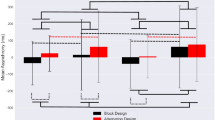Abstract
Under the influence of nicotine, an increase in EEG alpha frequency as well as finger tapping speed has been reported from separate experiments, and it has also been shown that tapping and alpha frequencies may correlate in defined experimental settings. The present study aimed at the analysis of smoking effects using parallel recordings of both EEG and finger tapping. Twelve healthy subjects were tested in two sessions (smoking deprivation versus smoking). After smoking, both dominant alpha frequency (P<0.05) and tapping performance (P<0.001) were higher than during deprivation. In most subjects, the increase of both parameters developed in parallel, and during phases of very stable tapping the ratio of alpha and tapping frequencies was close to 2:1. Both frequencies correlated during the deprived (r=0.6108,P=0.035) as well as the smoking (r=0.7009,P=0.011) conditions. Results confirm earlier findings regarding the effect of smoking upon EEG and tapping, and the parallel changes of both parameters may be attributed to the pharmacological properties of nicotine. Besides possible peripheral and spinal effects of nicotine, the increase of tapping performance parallels the increased frequency of central nervous pacemakers.
Similar content being viewed by others
References
Benowitz NL, Porchet H, Peyton J, III (1990) Pharmacokinetics, metabolism, and pharmacodynamics of nicotine. In: Wonnacott S, Russell MAH, Stolerman IP (eds) Nicotine psychopharmacology. Oxford University Press, Oxford, pp 112–157
Church RE (1989) Smoking and the human EEG. In: Ney T, Gale A (eds) Smoking and human behavior. Wiley, Chichester, pp 115–140
Frith CD (1967) The effects of nicotine on tapping. Life Sci 6:321–326
Golding JF (1988) Effects of cigarette smoking on resting EEG, visual evoked potentials and photic driving. Pharmacol Biochem Behav 29:23–32
Herning RI, Jones RT, Bachman J (1983) EEG changes during tobacco withdrawal. Psychophysiology 20:507–512
Knott VJ, Venables PH (1977) EEG alpha correlates of non-smokers, smokers, smoking, and smoking deprivation. Psychophysiology 14:150–156
Lippold OCJ, Williams EJ, Wilson CG (1980) Finger tremor and cigarette smoking. Br J Clin Pharmacol 10:83–86
Michel Ch, Hasenfratz M, Nil R, Bättig K (1988) Cardiovascular, electrocortical, and behavioral effects of nicotine chewing gum. Klin Wochenschr 66:72–79
Murphree HB (1979) EEG effects on humans of nicotine, tobacco smoking, withdrawal from smoking and possible surrogates. In: Remond A, Izard C (eds) Electrophysiological effects of nicotine. Elsevier, Amsterdam, pp 227–243
O'Connor K (1989) Individual differences and motor systems in smoker motivation. In: Ney T, Gale A (eds) Smoking and human behavior. Wiley, Chichester, pp 141–170
Pickworth WB, Herning RI, Henningfield JE (1986) Electroencephalographic effects of nicotine chewing gum in humans. Pharmacol Biochem Behav 25:879–883
Pögelt B, Roth N (1982) Frequency and phase relationship between the EEG and rhythmic automated movements. Acta Neurobiol Exp 42:163–173
Pögelt B, Roth N, Pögelt A (1984) Automated rhythmic movements and their control under different experimental conditions. Biochim Biomed Acta 4:485–491
Roth N (1989) Physiological concomitants of processing external feedback information in man. In: Sudakov K (ed) Systems research in physiology, vol II. Gordon & Breach, New York, London, pp 213–224
Roth N, Klingberg F (1971) Phasenbeziehungen zwischen Alpha-Wellen im EEG und automatisierter rhythmischer motorischer Tätigkeit. Acta Biol Med Germ 27:715–721
Shiffman SM, Gritz ER, Maltese J, Schneider NG (1983) Effects of cigarette smoking and oral nicotine on hand tremor. Clin Pharmacol Ther 33:800–805
Valeriote C, Tong JE, Durding B (1979) Ethanol, tobacco and laterality effects on simple and complex motor performance. J Stud Alcohol 40:823–830
Wesnes K, Warburton DM (1983) Smoking, nicotine and human performance. Pharmacol Ther 21:189–208
West RJ, Jarvis MJ (1986) Effects of nicotine on finger tapping rate in non-smokers. Pharmacol Biochem Behav 25:727–731
Author information
Authors and Affiliations
Rights and permissions
About this article
Cite this article
Roth, N., Bättig, K. Effects of cigarette smoking upon frequencies of EEG alpha rhythm and finger tapping. Psychopharmacology 105, 186–190 (1991). https://doi.org/10.1007/BF02244307
Received:
Revised:
Issue Date:
DOI: https://doi.org/10.1007/BF02244307



